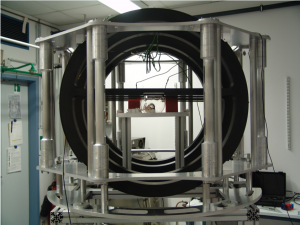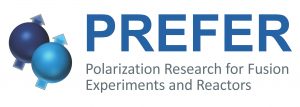We carry out experiments at external PW Laser facilities, such as Phelix in Darmstadt and SULF in Shanghai, which offer significantly higher pulse energies (at the expense of repetition rate) compared to the JuSPARC lasers.
These experiments allow us to gain experience with laser systems which may be part of a next JuSPARC stage.
The main scientific goal is to search for spin effects in relativistic plasmas. In particular, we
- Aim at the generation of laser-accelerated polarized proton and light ion beams
- Explore the possibility to use nuclear polarized fuel in fusion reactors
Generation of polarized proton and ion beams
The field of laser-induced relativistic plasmas and, in particular, of laser-driven particle acceleration, has undergone impressive progress in recent years. Despite many advances in the understanding of fundamental physical phenomena, one unexplored issue is how the particle (in particular hadron) spins are influenced by the huge magnetic fields inherently present in the plasma.
There are two mechanisms which can potentially cause a polarization of a particle beam in a plasma: either due to a spin alignment in the direction of the magnetic fields or by a spatial separation of different spin states induced by the field gradients. The second scenario relies on the same principle as the seminal Stern-Gerlach experiment in which a beam of neutral Silver atoms is deflected in an inhomogeneous magnetic field depending on the spin state of the valence electron.
From our previous studies it became clear that the above mentioned effects are expected to be negligibly small for most laser-induced particle acceleration schemes. Even the spin precession according to the T-BMT equation can be neglected in many cases. Thus, compact (gas-jet) targets are needed in which the nuclear spins are already aligned at the time of irradiation with the accelerating laser.
For the realization of polarized nuclear targets we currently follow two approaches:
- “Static polarization”: Hyper-polarized 3He gas with a spin relaxation time of many hours (when placed inside a proper holding field)

- “Dynamic polarization”: Nuclear polarized Hydrogen atoms produced during photo-dissociation of HCl gas.
This work is carried out within the ATHENA consortium.

Nuclear fusion with polarized fuel
The use of nuclear polarized fuel, i.e. polarized D, T or 3He, for coming fusion reactors promises to increase their energy output and to optimize the complete fusion process in various ways. But before these advantages can be utilized, several questions must be answered and technical issues must be overcome. Among others, the members of the PREFER collaboration started to investigate the different challenges of “polarized fusion”.

Further information can, for example, be found in our book Nuclear Fusion with Polarized Fuel.

